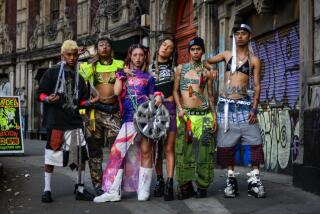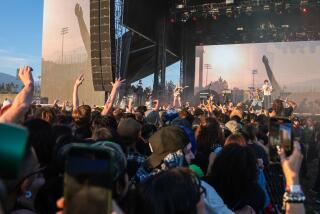Scooters Polished, Clothes Pressed : S.D. Mods Riding High for the Who
- Share via
SAN DIEGO — The Who is coming to town, and local mods like Bartley Mendoza and Scott Harper are ecstatic.
They are, after all, philosophical descendants of the English mods of the ‘60s, who considered the Who their preeminent musical ambassador.
The Who’s “music said a lot at the time, and still says a lot today,” said Mendoza, the 26-year-old leader of San Diego mod revival band Manual Scan. “They symbolized everything the first generation of mods stood for, and what we continue to stand for: freedom, rebellion, daring to be different.
“They went out of their way to canonize the mod legend with their ‘Quadrophenia’ album, plus they’re one of the few original mod groups you can still see, that’s still kicking.”
“The Who was one of the first mod bands, and they influenced every mod band that came later,” added Harper, a 22-year-old journalism student at San Diego City College.
“That’s why we look up to them as much as we do--they’re the fathers of our movement.”
Along with the estimated 400 other latter-day mods living in San Diego, Mendoza and Harper spent much of last weekend polishing their scooters, ironing their pegged pants and narrow-lapel shirts, and taking their parkas to the dry cleaners in preparation for tonight’s Who concert at San Diego Jack Murphy Stadium.
Just after noon today, they’ll start arriving in Balboa Park for a preconcert rally around the El Cid statue. Compact discs by the Who will be awarded to the mod with the nicest Vespa scooter, the mod with the nicest Lambretta, and the mod who traveled the farthest distance. Joining the local contingent will be mods from Los Angeles and as far away as Phoenix.
“I’ve got friends coming in from all over the western United States,” Harper said. “It’s going to be a real reunion. I expect to see a lot of faces I haven’t seen since 1982, the last time the Who played San Diego.”
At 3 p.m., the mods will caravan to the stadium.
“Because the Who is currently on its 25th anniversary reunion tour, a lot of people are saying that they’re washed up, that they’ve had it,” Harper said. “But how can you say that when they’re reuniting mods from all over the country, kids whose only common bond with the original mods from England is the chance to see the Who in their own town?”
The first generation of mods consisted of working-class youth from London rebelling against society.
They wore fancy duds like Italian mohair suit jackets, pegged pants, dressy shirts with narrow lapels and pointy leather shoes.
“At the time, that was real rebellious,” Harper said, “because kids were not supposed to dress up for shows.”
They got around on scooters rather than cars, Mendoza added, “because scooters typified freedom: they didn’t tie you down; you could drive, and park, wherever you wanted to, in places where cars couldn’t.”
They donned parkas “to prevent their clothes from getting wet or disheveled by the wind,” Mendoza said. And, instead of the cheery mop-top music of the Beatles and other purveyors of the so-called “Liverpool sound,” they listened to black American rhythm-and-blues, as interpreted by such
British bands as the Small Faces, the Action, Them, and the Who, who had burst out of London’s blue-collar West End playing a wild mix of James Brown, Motown and blues covers.
“The Who was the first band to go out into the neighborhoods, into the suburbs, and unite mod kids from all over Britain,” Harper said. “In their songs, they talked to the kids in their own language--they not only understood what the mods were all about, they were part of it.”
The English mod scene peaked in the middle 1960s, when the Who topped the charts with such anthems as “My Generation” and “The Kids Are All Right.”
“Eventually, the whole mod movement got so big that, even in America, department stores like Sears had mod fashion sections . . .,” Mendoza said.
“It was more than just a movement; it was an attitude, a life style.”
By the end of the 1960s, mod had become passe, and acid-rock and psychedelia were the latest rage. And yet in the middle ‘70s, the movement began a revival that has since seen hordes of second-generation mod kids listening to the same music, wearing the same clothes, and espousing the same attitude as their first-generation mod parents.
“It’s just something we can identify with, this feeling of rebelliousness, of youth, that the original mods stood for,” Mendoza said. “And the Who captured this feeling perfectly.”
After today’s Who concert, Mendoza said, most of the local mods will go for a cappuccino at the Gelato Vero Caffe in Mission Hills or dancing at the 2581, a hip dance club in East San Diego. Both are regular mod hangouts.
More to Read
The biggest entertainment stories
Get our big stories about Hollywood, film, television, music, arts, culture and more right in your inbox as soon as they publish.
You may occasionally receive promotional content from the Los Angeles Times.










